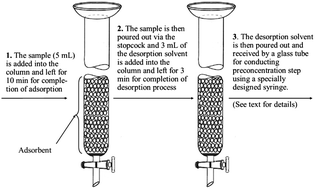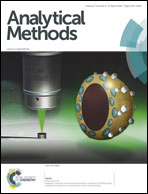Evaluation of polytetrafluoroethylene as a novel selective adsorbent for solid phase extraction followed by RP-HPLC determination of synthetic pyrethroids from surface waters
Abstract
The phenomena of selective adsorption of synthetic pyrethroids on polytetrafluoroethylene containers observed while storing contaminated water samples, has been reversibly exploited for quantitative solid phase extraction followed by their determination by RP-HPLC. A specially designed glass column packed with very fine pellets of polytetrafluoroethylene was used as a SPE cartridge and factors affecting adsorption/desorption processes were optimized. High enrichment factors ranging 1882–3318 were obtained with detection limits as low as 0.03–0.06 ng mL−1. When compared with the conventional C18-based SPE, it showed good selectivity against highly and moderately polar organic compounds making it superior to C18 SPE particularly for extraction of synthetic pyrethroids from complex aqueous media. This is the first report on the use of polytetrafluoroethylene as SPE adsorbent for selective extraction and quantitative determination of synthetic pyrethroids from contaminated surface waters.


 Please wait while we load your content...
Please wait while we load your content...